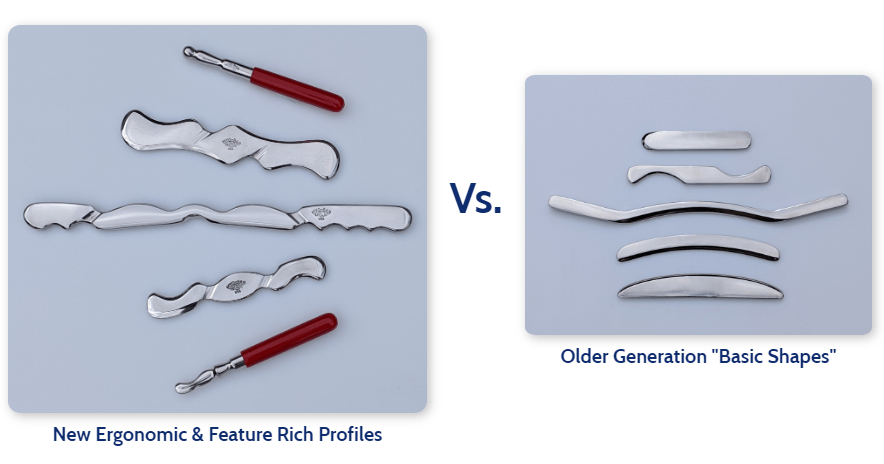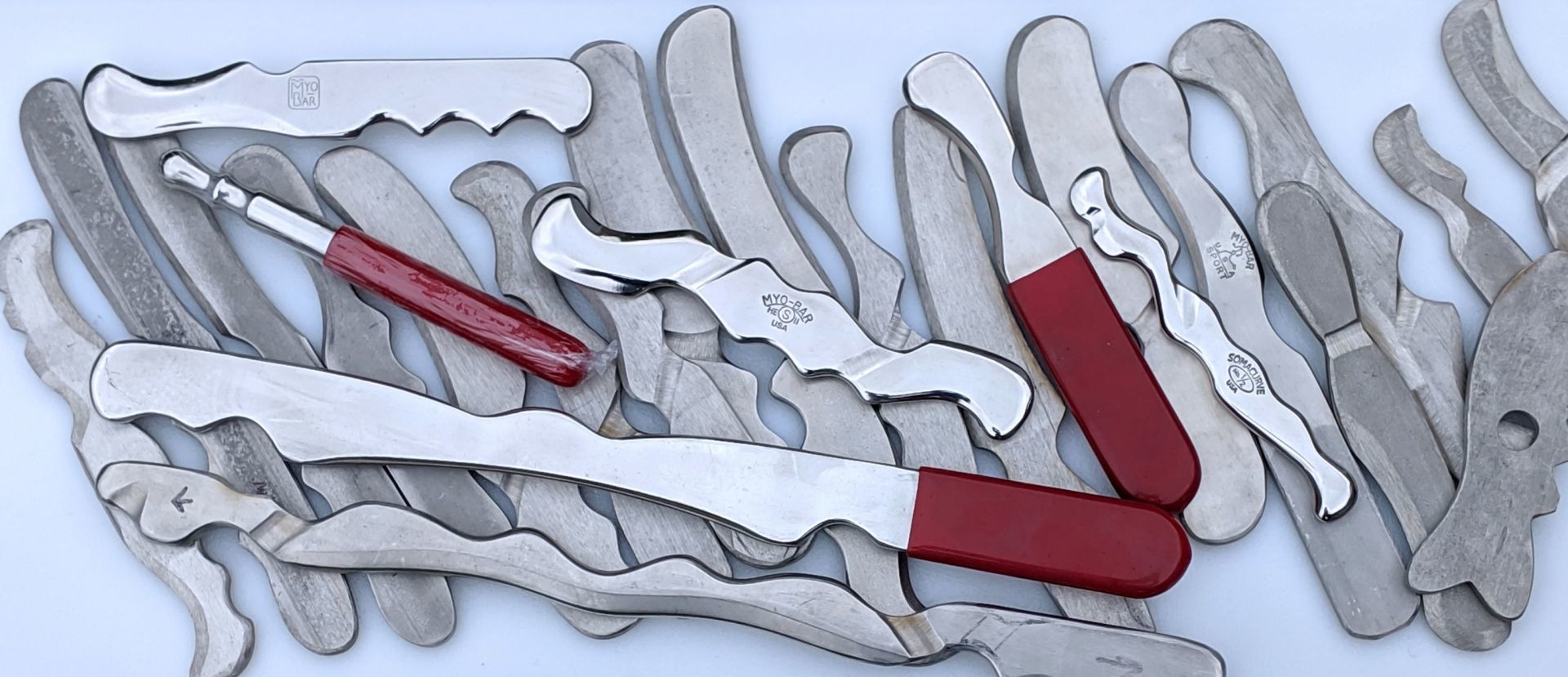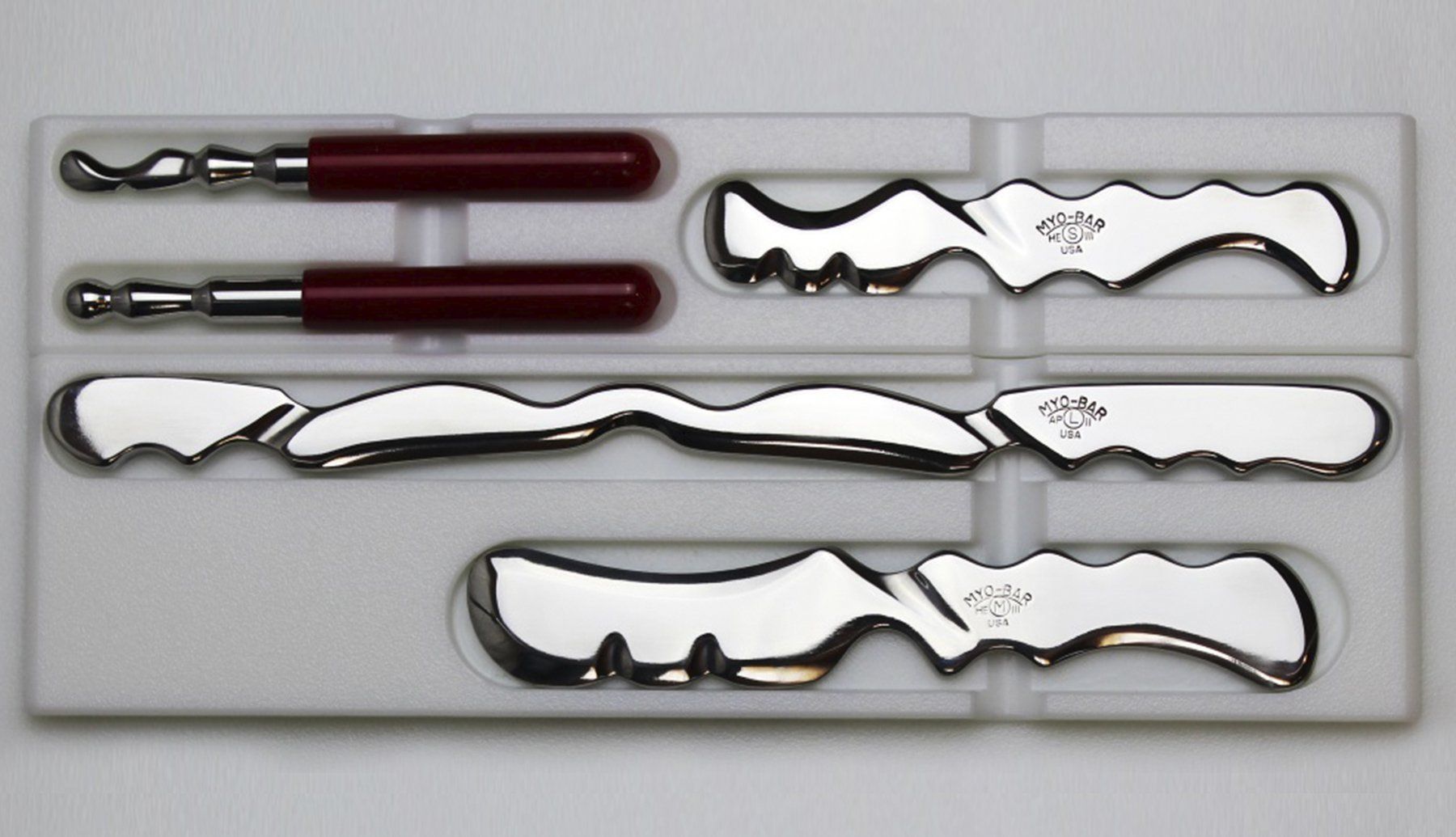Used Graston Tools for Sale: Are There Better Choices for Clinical Practice in 2021?
Matt Hajzl, DC • May 5, 2021
The Graston Tool Profiles were created in 1996. At the time they were the best available option for integrating IASTM (instrument assisted soft tissue mobilization) with other myofascial therapies. Today, many manufactures offer the same basic shapes from two decades ago... are there better choices today?

Yes, there are
5 benefits to new designs
that make treatment more effective.
Who better to come up with improved Graston tool designs than a 20 year soft tissue veteran? I've noticed that many of the myofascial edge tools on the market today are just copies of the same old shapes. I designed better profiles for my own practice back in 2001, that skyrocketed my success with soft tissue injuries. But, before I share with you the five benefits of new designs- I should probably tell you what's wrong the the old ones.
The old GT profiles are inefficient. Sorry if that seems harsh. But, you'll see that not all of the instrument profile has been utilized for treatment edges. On the "tongue depressor" shaped GT tool only the end is finished, leaving 80% of the perimeter profile unusable for treatment. Other Graston tools for sale only have half of the instrument profile finished with a treatment edge.
This means more expense (needing more individual tools to cover the basic treatment profiles) and it means more tool switching and cleaning. If your profile had three or more common geometries it would make for much more efficient use of your time performing myofascial therapy.
Also, if that weren't a deal breaker, the profiles also suffer from serious lack of ergonomic foresight. Unfortunately, an uncomfortable "pinching" hold is required to manipulate the tools, and without finger grip features they are prone to sliding out of the hand (especially when emollient is used). If you have seen Graston Technique demonstrated you will often notice clinicians using blue or purple nitrile gloves to help with grip. Its pretty obvious that this would be an inconvenience to glove up for each IASTM therapy.
I
noticed these issues way back in 2001 when I was first trained in the Graston Technique. After much trial and error, much professional feedback, and heaps of prototypes in the scrap bin I was able to improve the tools with five design benefits.
Just a small sample of the many profiles I tested to improve legacy Graston Tools.
Benefits That Clearly Offer Better Designs
than Legacy Graston Instruments:
1.
Integral Ergonomics
- finger rests, notches, and hollows designed into the profile prevent slipping and act as a natural fulcrum for easy tissue strokes. Also, because the finger features are not machined with the sharper treatment bevels, they can be held securely without discomfort.
2. Dynamic Profiles Geometries- There is no reason a myofascial tool should be limited to one profile. Why not pack as many treatment features as you can into a single tool? When you are in the midst of treatment that last thing you want to do is set down and pick up a bunch of different tools. The more you can do with the tool you have in your hand, the better.
3.
Expanded Range of Treatment Targets- how about a myofascial bar with an "elbow" like profile for locking into the deep layers of large muscle groups like the quads or hamstrings? How about a very small profile with scalpel like focus able to get into small capsules and along nerve channels?
4. The Large Radius Edge
(LRE)- The traditional edges are able to penetrate about 3/4" into the tissues. If you have to work deeper, or you are working on sensitive or inflamed tissue you become limited as the treatment can become painful. Not so with a Large Radius Edge. Having this feature gives you so much more flexibility not to mention makes your patients much more comfortable.
5. Scaled for Anatomy- Most regional soft tissue injuries are best treated with a tool sized correctly for both the target tissue and for the depth and amplitude of stroke. Instead of "one-sized-fits-all" profiles, a dynamic geometry includes all necessary profiles in (S) small, (M) medium, & (L) large tools. As an example, when I select a small tool for treating the wrist extensors I know I have every contact necessary.
Better Than Used Graston Tools for Sale in 2020
Consider that instead of looking for used Graston tools for sale, there are better options available. If you are doing research about tool assisted myofascial therapies, please don't hesitate to contact me with an questions. Soft tissue work is my passion and is still underutilized in our medical system (in the United States). The more practitioners that integrate myofascial therapies the better we can serve the patient population.
I'll admit that the MyoBar brand is not the only quality alternative to Graston. What I will say is that nobody in the world offers the level of quality and features at our prices. Sadly, there are many American manufactures that have come and gone mainly due to the cheap Chinese imports. You'll see these sets re-branded over and over with different logos and vendors, but they are they all come from the same place. If you are really strapped for cash they can get the job done, but for a small percentage more you can have comfort, functionality, and efficiency that will serve you and your patients for the life of your practice.
The
Ultimate Alternative to Used Graston Tools for Sale:
MyoBar Advanced Practice Healing Edge 3 Set
A
picture is worth a thousand words. All 5
design improvements that benefit your clinical practice can be found in the Advanced Practice Healing Edge 3 Set. Although you have many options for alternative Graston tools for sale, its worth checking out this set. Even if you already have some myofascial tools you can upgrade for less than you think.
Besides other informative blog posts, you may also want to check out the Technique Page and watch the 4 basic IASTM tissue stroke videos and download our 45 Page IASTM Technique Primer PDF on the Must Read/Technique Page.
About Dr. Matt Hajzl
I attended the first Graston Technique seminar in Chicago in 2001 and realized the potential of instrumented soft tissue therapies could be improved greatly with three things: expanded range of profile geometry, ergonomic hand hold features, & non-proprietary educational resources. In 10 years, MyoBar has become a leader in the field with thousands of instruments in use in the United States and over 50 countries worldwide.
Sign up for the IASTM newsletter below for clinical pearls & periodic promotions on MyoBar IASTM Tools




